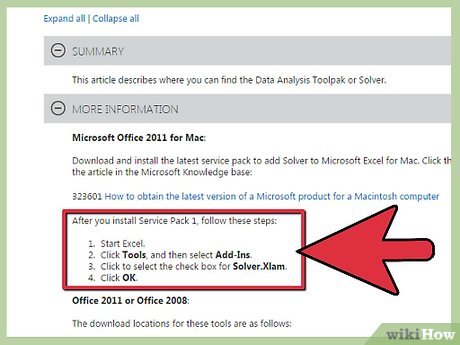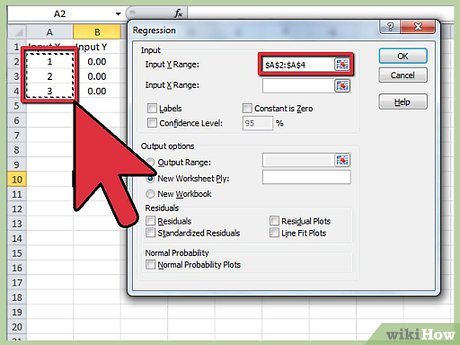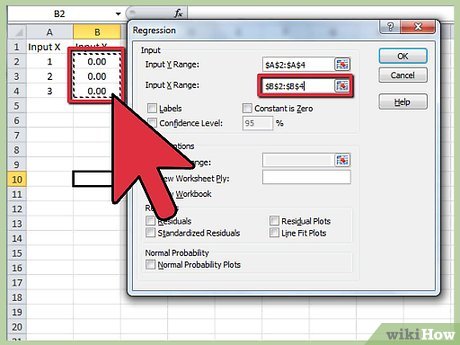How to Run Regression Analysis in Microsoft Excel
Method 1 of 2:
Make Sure Regression Analysis Is Supported On Your Excel
-
 If your version of Excel displays the ribbon (Home, Insert, Page Layout, Formulas…)
If your version of Excel displays the ribbon (Home, Insert, Page Layout, Formulas…)- Click on the Office Button at the top left of the page and go to Excel Options.
- Click on Add-Ins on the left side of the page.
- Find Analysis tool pack. If it's on your list of active add-ins, you're set.
- If it's on your list of inactive add-ins, look at the bottom of the window for the drop-down list next to Manage, make sure Excel Add-Ins is selected, and hit Go. In the next window that pops up, make sure Analysis tool pack is checked and hit OK to activate. Allow it to install if necessary.
-
 If your version of Excel displays the traditional toolbar (File, Edit, View, Insert…)
If your version of Excel displays the traditional toolbar (File, Edit, View, Insert…)- Go to Tools > Add-Ins.
- Find Analysis tool pack. (If you don't see it, look for it using the Browse function.)
- If it's in the Add-Ins Available box, make sure Analysis tool pack is checked and hit OK to activate. Allow it to install if necessary.
-
 Excel for Mac 2011 and higher do not include the analysis tool pack. You can't do it without a different piece of software. This was by design since Microsoft does not like Apple.
Excel for Mac 2011 and higher do not include the analysis tool pack. You can't do it without a different piece of software. This was by design since Microsoft does not like Apple.
Method 2 of 2:
Run Regression Analysis
-
 Enter the data into the spreadsheet that you are evaluating. You should have at least two columns of numbers that will be representing your Input Y Range and your Input X Range. Input Y represents the dependent variable while Input X is your independent variable.
Enter the data into the spreadsheet that you are evaluating. You should have at least two columns of numbers that will be representing your Input Y Range and your Input X Range. Input Y represents the dependent variable while Input X is your independent variable. -
 Open the Regression Analysis tool.
Open the Regression Analysis tool.- If your version of Excel displays the ribbon, go to Data, find the Analysis section, hit Data Analysis, and choose Regression from the list of tools.
- If your version of Excel displays the traditional toolbar, go to Tools > Data Analysis and choose Regression from the list of tools.
-
 Define your Input Y Range. In the Regression Analysis box, click inside the Input Y Range box. Then, click and drag your cursor in the Input Y Range field to select all the numbers you want to analyze. You will see a formula that has been entered into the Input Y Range spot.
Define your Input Y Range. In the Regression Analysis box, click inside the Input Y Range box. Then, click and drag your cursor in the Input Y Range field to select all the numbers you want to analyze. You will see a formula that has been entered into the Input Y Range spot. -
 Repeat the previous step for the Input X Range.
Repeat the previous step for the Input X Range. -
 Modify your settings if desired. Choose whether or not to display labels, residuals, residual plots, etc. by checking the desired boxes.
Modify your settings if desired. Choose whether or not to display labels, residuals, residual plots, etc. by checking the desired boxes. -
 Designate where the output will appear. You can either select a particular output range or send the data to a new workbook or worksheet.
Designate where the output will appear. You can either select a particular output range or send the data to a new workbook or worksheet. -
 Click OK. The summary of your regression output will appear where designated.
Click OK. The summary of your regression output will appear where designated.
Sample Regression Analyses
 Sample Regression Analysis
Sample Regression Analysis Sample Regression Analysis for House Size
Sample Regression Analysis for House Size Sample Regression Analysis for Blood Pressure
Sample Regression Analysis for Blood Pressure4 ★ | 1 Vote
You should read it
- How to use Quick Analysis in Excel
- Data Analysis in Excel
- Instructions on how to create input forms in Excel extremely fast and simple
- Summary of 50 Excel shortcuts you should know by 2023
- SLOPE function - The function returns the slope of a linear regression line through data points in Excel
- How to turn off content suggestions on Excel
- 4 Advanced PivotTable Functions for Excel Data Analysis
- STEYX function - The function returns the standard error of the predicted value of y for each value of x in regression in Excel
May be interested
- How to Do Trend Analysis in Excel
 this wikihow teaches you how to create a projection of a graph's data in microsoft excel. you can do this on both windows and mac computers. open your excel workbook. double-click the excel workbook document in which your data is stored.
this wikihow teaches you how to create a projection of a graph's data in microsoft excel. you can do this on both windows and mac computers. open your excel workbook. double-click the excel workbook document in which your data is stored. - What is data analysis?
 data analysis is the process of evaluating data using statistical or analytical tools to discover useful information. some of these tools are programming languages like r or python.
data analysis is the process of evaluating data using statistical or analytical tools to discover useful information. some of these tools are programming languages like r or python. - 8 best features in Excel 2013
 users can enjoy the feature of filling flash fill data or innovations on recommended charts, recommended pivottables and new features quick analysis, timelines. here are 8 best features in excel 2013 that are useful for most users.
users can enjoy the feature of filling flash fill data or innovations on recommended charts, recommended pivottables and new features quick analysis, timelines. here are 8 best features in excel 2013 that are useful for most users. - 5 useful Microsoft Excel formulas for calculating taxes
 you can spend big money to hire an experienced accountant handles this, or make use of excel power immediately to arrange things in order. here are five recipes that can make your life 'breathable' than in 'season' tax.
you can spend big money to hire an experienced accountant handles this, or make use of excel power immediately to arrange things in order. here are five recipes that can make your life 'breathable' than in 'season' tax. - Summary of expensive shortcuts in Microsoft Excel
 in the work, especially when you have to perform many calculations, the formula in microsoft excel documents, the use of the mouse is strictly tortuous. not wrong, because when you master the formulas, shortcut keys on excel, using the keyboard will be fast and convenient a lot.
in the work, especially when you have to perform many calculations, the formula in microsoft excel documents, the use of the mouse is strictly tortuous. not wrong, because when you master the formulas, shortcut keys on excel, using the keyboard will be fast and convenient a lot. - Complete guide to Excel 2016 (Part 1): Get familiar with Microsoft Excel
 microsoft excel is a spreadsheet processing program designed to record, present processing information in tabular form, perform calculations and build visual statistics in the table. join tipsmake.com to get acquainted with microsoft excel 2016!
microsoft excel is a spreadsheet processing program designed to record, present processing information in tabular form, perform calculations and build visual statistics in the table. join tipsmake.com to get acquainted with microsoft excel 2016! - How to Use Excel
 this wikihow teaches you how to set up and use microsoft excel on your windows or mac computer. install microsoft office if you don't have it. microsoft excel isn't available as a standalone program, but it is included in a microsoft...
this wikihow teaches you how to set up and use microsoft excel on your windows or mac computer. install microsoft office if you don't have it. microsoft excel isn't available as a standalone program, but it is included in a microsoft... - Guide to full Excel 2016 (Part 2): Learn about OneDrive
 in the introduction in excel 2016, tipsmake.com helped you get acquainted with microsoft excel. today, we continue to share with you about things to know about onedrive. invite you to consult!
in the introduction in excel 2016, tipsmake.com helped you get acquainted with microsoft excel. today, we continue to share with you about things to know about onedrive. invite you to consult! - Link Download Microsoft Excel Viewer 12.0.6611.1000
 microsoft excel viewer is a free program that allows you to view and print spreadsheet documents created in microsoft excel, without having to install the program on your pc.
microsoft excel viewer is a free program that allows you to view and print spreadsheet documents created in microsoft excel, without having to install the program on your pc. - MS Excel - Lesson 11: Solving the problem of Excel Help feature?
 are you having trouble using excel? try the microsoft excel help features
are you having trouble using excel? try the microsoft excel help features
















 How to Add Up Columns in Excel
How to Add Up Columns in Excel How to Search for Words in Excel
How to Search for Words in Excel How to Unshare an Excel Workbook
How to Unshare an Excel Workbook How to Use the Sum Function in Microsoft Excel
How to Use the Sum Function in Microsoft Excel How to Integrate Large Data Sets in Excel
How to Integrate Large Data Sets in Excel How to Make Tables Using Microsoft Excel
How to Make Tables Using Microsoft Excel